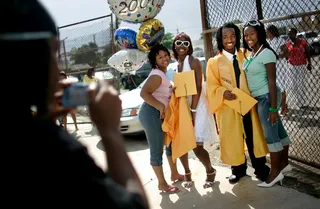The Road to Higher Education for Black and Latino Males
Minority male students want to transcend poverty levels.

1 / 9
A Look at Black and Latino Males High School Performance - The Open Society Foundation, the Study of Race and Equity in Education at the University of Pennsylvania and the New York City Department of Education recently released Succeeding in the City, a high school achievement study featuring 325 Black and Latino males from 40 public high schools in New York City. The report outlines disproportions in NYC’s minority male high school success rates and how and why Black and Latino males aren’t making it to college. — Dominique Zonyéé(Photo: Hill Street Studios/GettyImages)

2 / 9
The Overview - Overall, Black and Latino males are often on the lowest part of the educational ladder. NYC has the sixth largest Black-White male gap in four-year high school graduation rates among urban districts that enroll 10,000 or more Black male students. Furthermore, around 60 percent of Blacks and 60 percent of Latinos graduate within four years.(Photo: Hill Street Studios/GettyImages)

3 / 9
Labeling Minority Males - Similar to the prison system, the statistics for behavioral issues are disproportionately overpowered by Black and Latino males. Nearly 50 percent of Black male and 29.6 percent of Latino male students from grades 6-12 were suspended from school in 2011; compared to 21.3 percent of their White male peers. Furthermore, Black boys had been expelled 13 times more than that of white boys.(Photo: Hill Street Studios/Matthew Palm/GettyImages)

4 / 9
Graduation Success Rates - Nationally, 52 percent of Black males and 58 percent of Latino males graduated in four years from high schools where they began as ninth graders, compared to 78 percent of their White male classmates. Additionally, in 38 states and the District of Columbia, high school graduation rates for Black males were lowest among all racial groups.(Photo: Mario Tama/Getty Images)
Photo By Photo: Mario Tama/Getty Images

5 / 9
Higher Education Preparation - Only 9.3 percent of Black and 11.4 percent of Latino men who entered high school in 2006 as ninth graders were deemed “college ready” four years later. Only 6.2 percent of Black males and nine percent of Latino males graduated in 2010 with Advanced Regents Diplomas, compared to 34.3 percent of white men.(Photo: Mario Tama/Getty Images)
ADVERTISEMENT

6 / 9
New York Stands Up - Launched in 2012, New York City Department of Education’s Expanded Success Initiative (ESI) uses innovative approaches such as the Mayor’s Young Men’s Initiative (YMI) to tackle the educational achievement gap and increase the number of Black and Latino young men who graduate high school and prepare for college.(Photo: GettyImages)

7 / 9
Digging Deeper - In order to further access the achievements of Black and Latino high school students at 40 ESI schools, Penn GSE Professor Shaun R. Harper conducted a study of 325 Black and Latino male students from urban and often crime riddled communities. The study focused on family structure, immigration status, parents’ education level and even a morning commute to school.(Photo : Mario Tama/Getty Images)

8 / 9
The Results - The study found more than 70 percent of the students had both parents who did not receive higher education. However, students attributed their parents, teachers, and yearning to escape poverty by means of higher education to their academic success and college readiness.(Photo: Commercial Appeal /Landov)
